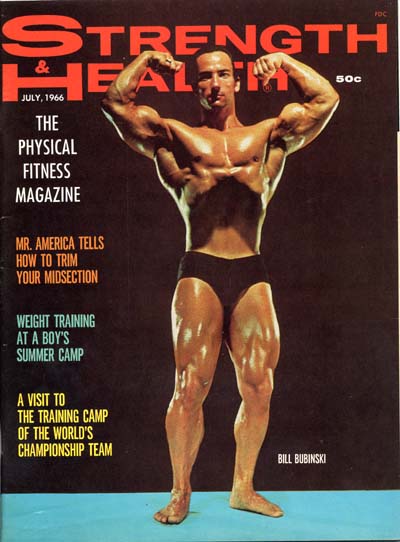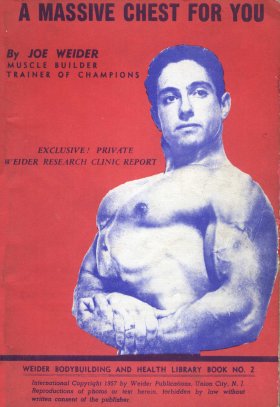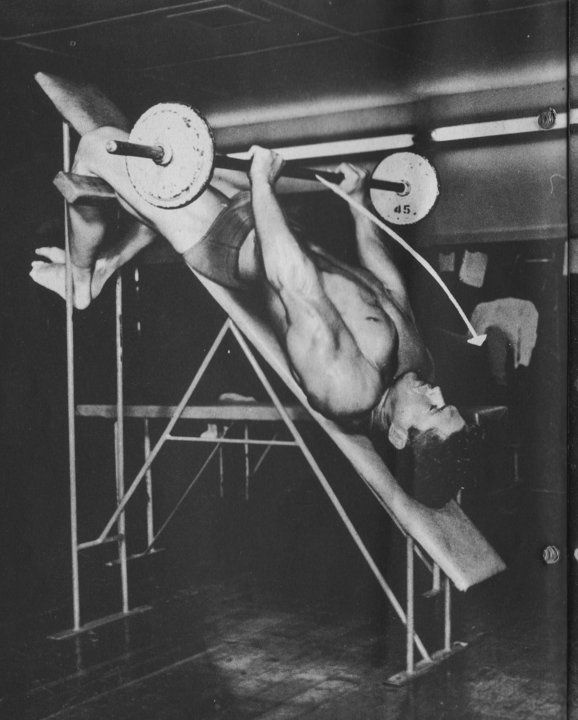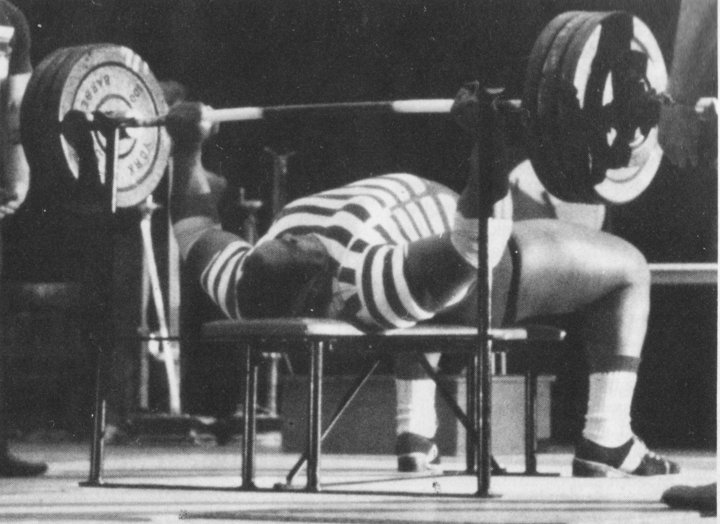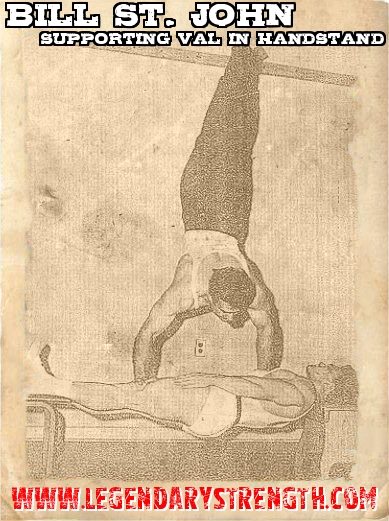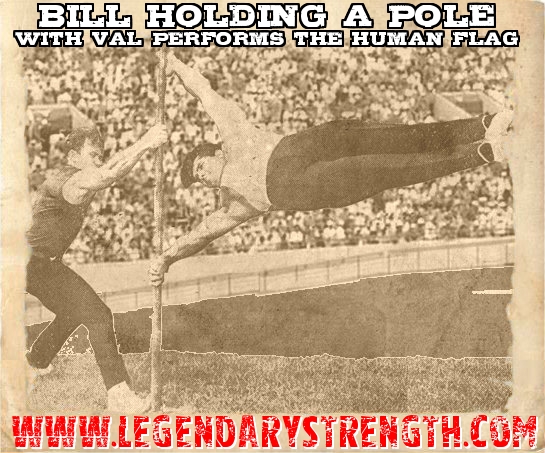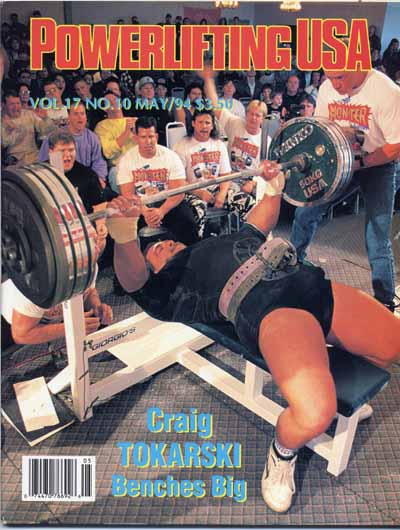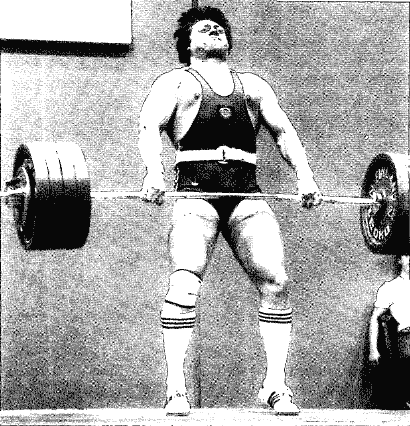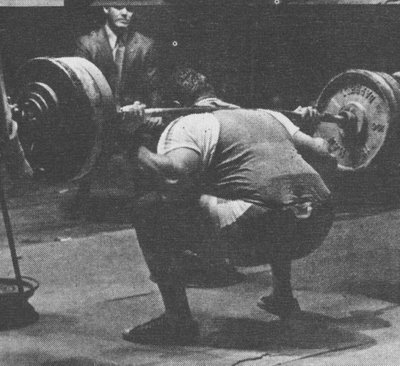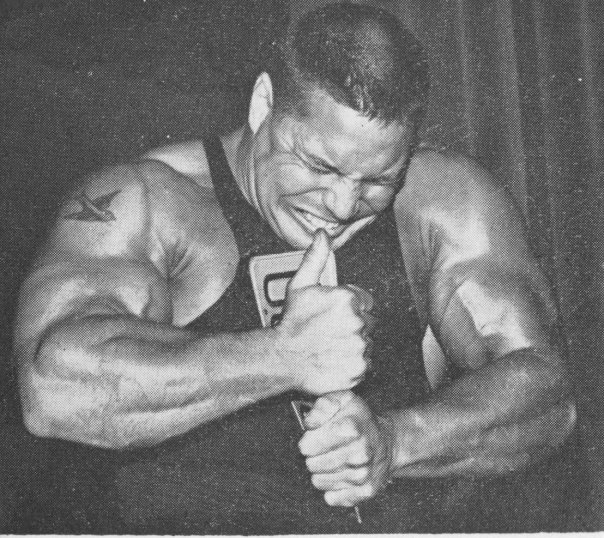That Cadillac Guy
by Jan Dellinger (2017)
Back in the day, bodybuilding superstar Bill Pearl referred to 1964 AAU Mr. America winner Val Vasilef by he nickname "That Cadillac Guy."
For decades, the label "Cadillac" has symbolized the ultimate top-of-the-line quality, elegance, style and, frankly, affluence! Hence, Pearl hit the nail right on the head when he hung this esoteric handle on Val, whose life post-bodybuilding exemplifies what is synonymous with the vaunted luxury automobile.
While on the subject of monikers I have always looked upon Val as "The Comet!" My reasoning stems from the fact that when he won his Mr. America crown, I was in junior high school and just starting to read York muscle magazines in which he was prominent. However, by the time I reached high school, Val had vanished from these publications. And now you know one of my motivations for re-examining Val.
All of this brings up an interesting but seldom-addressed-point germane to amateur bodybuilding in the 1960s: what did these prominent Mr. Winners do after they walked off with the big titles back then? I'll touch on that issue directly by contrasting the post-Mr America life path Val went down against that of another titlist of that same period.
For now, let's just say that Val Vasilef was one muscleman who ultimately did quite well for himself after he stepped off the posing dais. How well, you ask? Hes beyond opulent abode in south Florida, which features Mediterranean Moorish Mythical design themes while also encompassing hints of Spanish-Italian influences, is regular cover material for every upscale real estate industry publication far and wide.
While the later chapters of Val's life speak volumes of his accomplishments, his early years portray the absolute antithesis of a Cadillac lifestyle. Frankly, the description "struggle" doesn't do his young years justice as he and his family were mired in abject poverty. When Val was approximately eight years old, his father suffered a severely crippling accident and in not time flat the Vasilef's were homeless and literally out on the street.
Click Pics to ENLARGE
In short order, they became wards of the state of New Jersey, who relocated them to a "place to live" (note the quotes) in the general vicinity of the town of Glassboro. This formerly abandoned residence was w-a-y out of town, situated well beyond where the paved roads ended. Additionally, foremost among the deficiencies of this 'shelter" was the complete lack of electricity, refrigeration, and indoor plumbing.
![]()
To this day, Val credits the ingenuity and tenacity of his mother for keeping the family together and eking out a sustainable existence in these sub-standard circumstances. On the plus side, although in the wilderness, this property had sufficiently rich earth to grow vegetables and other life-giving crops, as well as to proliferate "agri-currency" in the form of raising chickens. Fortunately, there was also an abundance of trees available on the land, which provided the only reliable heat source during the winter months. Of course, this required that Val and his brother constantly saw and chop wood. Talk about an old school workout!
Clearly, there was nothing easy or encouraging about their circumstances. Nevertheless, through collective grit, self-reliance, along with an early tendency toward very basic
entrepreneurialism, the Vasilefs honed a finely tuned survival instinct. Nearly two years later, the state of New Jersey "upgraded" the Vasilefs to a just-slightly-less dilapidated "fixer upper" in that it featured very basic electrical wiring, but Val and his brother Bob had to hand-dig the cesspool for the house, and eventually were able to put the bathroom indoors. Recognize that for a lot of Americans, the hard scrabble day-to-day of the Great Depression did not start reversing until after the cessation of World War II. ![]()
Val was personally molded and matured by these regular hardships. Plus, he innately possessed a couple of other attributes which served him well: Among them was a transcendent, indomitable spirit, which incorporated an incredible degree of self-determination to strive and rise above his bleak situation. Hence, earning money was a high priority to Val. At the same time, he was the type of individual who was not content working for someone else. So, at age 17, he, his brother Bob and a friend, also teenagers,went into the professional roofing/siding business in the Turnersville, NJ area. Thanks to Val's tremendous energy and hustle, they successfully competed on even terms with more established businesses in the same field who were owned and operated by adults.
![]()
Of course, there are different standards of success among businessmen, even the younger ones! After earning enough to start pulling the Vasilef brood out of the economic mire, Val and his brother had amassed sufficient dollars to purchase a . . . green Cadillac convertible. Perhaps Bill Pears is a psychic!
Okay, what would you expect of two teenage boys from a financially indigent background who had money for the first time! Their sporty set of wheels caught the eye of many of those cute 1950s Jersey girls in saddle shoes and poodle skirts. As Val has summed it up in his autobiography, " . . . could life be any better? Not for two teenage boys who were just a few years before at the bottom of the barrel."
The Caddy and pocket money were not the only lures in attracting the chick-a-dees as the handsome Vasilef brothers were also adept at showing off physically. Two of their specialties were acrobatic handbalancing on various sections of the Caddy, as well as other odd and precarious objects, and free style open somersaults. A bit of a daredevil, Val, in particular, was exceptional at handstand presses on his motorcycle, eventually after a number of spills, being able to hold one while the motorcycle was moving! Pictorial documentation of the aforementioned is on display in his autobiography, "My Journey to Mr. America."
By the way, Val retained this incomprehensible ability at handbalancing even as a full-fledged muscleman weighing well over 200 pounds. In fact there is an iconic picture of Val doing a handstand on top of fellow training partner/competitor Bill St. John. Note should also be taken that the latter is holding a rigid plank with only his feet and back of his head supported.
Reference to his motorcycle, points to another chapter in Val's young (pre-bodybuilding) life. As a form of economic transportation, the motorcycle began gaining wide usage in post World War II America. Val locked into the chopper craze, acquiring a very used one before he could legally drive a car and upgraded from there.
The prevalence of motorcycles on America's highways gave rise to the formation of motorcycle "clubs." And there was a mixed image that went with bike life in many quarters by the dawning of the 1950s. Some clubs were nothing more than a group of friends or acquaintances bonded together by the love of riding the open road in their free moments.
At the same time, clubs featuring members who also loved riding the open road but who also didn't mind living outside the law to various degrees also sprang up. Typically, these kinds of bikers were classified by law enforcement as gangs. Typically, these assemblages not only flaunted authority, but maintained criminal enterprises to subsidize their adventurous lifestyle.
Reflectively, it is stunning how contemporary history views our culture in the rear view mirror. Typically, the 1960s are remembered as the decade of upheaval and discontent. But because art mirrors culture, there were signs even in the early 1950s that more than a little nonconformity was headed mainstream America's way. For example, the 1953 movie, "The Wild One", which featured renowned actor Marlon Brando as troubled tough Johnny Strabler, was the first film to explore outlaw biker life. As a work of filmdom, Brando and this movie have attained a near-immortal/iconic status.
Then there was the dark, brooding personality - young girls often seem attracted to this moody kind of bad boy - of James Dean in "Rebel Without a Cause".
And then there was the emergence of an unprecedented and enduring cultural force who was distasteful to older generations at first -- "The King of Rock and Roll" - Elvis Presley flashed the good looks, charisma, sensuality and tons of energy on the stage, exuding the ultimate in Alpha Male "IT".
In movie roles, Elvis was, of course, the romantic lead, who sometimes rode a Harley with compatriots, and when threatened, triumphantly beat down unruly antagonists. Basically, the boy-next-door with minor tinges of acceptable adult male hostility to his character in order to entice females who loved the Bad Boys, as well as the good ones!
The aforementioned trio to a large extent defined young American males and youthful rebellion from an image standpoint when Val was a teenager. So where on this sliding scale of '50s male role models would Val, who was an avid and unabashed motorcycle enthusiast who led his own club (The Cats) slot in? Clearly, closer to the Elvis profile than Brando's persona, but make no mistake about it, Val was the uncontested leader of his biker crowd and was not shy about defending his throne!
Like Elvis, Val was, and remains, very much a child of the 1950s. One of the living areas contained within that fabulous mansion of his which I mentioned early on features a full-to-scale malt shop/diner (replete with a counter, soda fountain, booths, stools, iconic period posters and other wall art . . . the whole nine yards!). And he has been known to impersonate Elvis - hair, attire, glittered jump suit, etc. - expertly for the entertainment of party go-ers and friends.
And like Elvis, Val had his own brand of Alpha Male "IT", and lots of it, even as a teenager. His level of ambition, and especially when challenged or told he couldn't do something, was incredible. And as one admirer who recalled his initial citing of Val back in the day phrased it, "There was nothing like him. He just looked different from everyone else and exuded an aura of supreme confidence about him."
Before I reveal the identity of the person I just quoted - it's a name bodybuilders of a certain age will recognize - I would like to offer more of his background thoughts, expressly concerning his first view of weights and Val: "I was a 14-year old walking past a yard where a group of older guys were lifting weights, which at that time was a rare sight because the activity was discouraged by coaches of all sports at all levels, even the pros.
"Because I was so enamored with the Superman serials at the Saturday movie matinees when I was younger, watching these guys that day provided the inspiration for my lifelong involvement in weightlifting.
"One of the boys participating was a high school senior and very accomplished athlete. This captain of the local school football and baseball teams, cleaned and jerked 185 pounds. I thought, 'Wow!' . . . figuring that was the best effort I was going to see.
"This I caught sight of someone in the group who just looked different from anyone I'd ever seen before. He complimented the sports hero on his impressive lift, saying in a tongue-in-cheek manner that he doubted he could equal cleaning and jerking the 185. But he said he wanted to try it nevertheless.
"The upshot of the story is that this very intriguing individual cleaned the 185 and pressed it . . . with one arm!
"Just as quickly, Mystery Guy climbed on his motorcycle and sped off! My first thought was, 'Who the hell was this guy, and what did I just witness?'
"At my age I only got to see him infrequently when he came around, but when he did, his presence always created a stir. Finally, I learned that he was Val Vasilef!"
The above are the first impression recollections of Bill St. John, who grew up to be a very high caliber bodybuilder and individual in his own right. Moreover, those of you who lived thru the bodybuilding history of the middle-late 1960s thru early ''70s, will know that Bill and Val were by that point lifelong friends and training partners.
Actually, very substantial facts and background details for this article were furnished by Bill, and as such should be considered the real author of this Vasilef profile.
However, returning to Val and his exploits chronicled thus far, I'm guessing a lot of readers raised an eyebrow when a 185-pound One-Arm Press was attributed to the former Mr. America. As with every great muscleman or strongman, Val literally oozed genetic potential, most directly traceable to his mother's brother John, who was a touring professional strongman for decades with prominent circuses in his native Russia.
This does not mean that he enjoyed his physical blessing without working to improve upon it. As previously mentioned, he innately possessed gymnastic abilities, which he began cultivating at a rather young age. Moreover, he also wanted to emulate his uncle's great capacity for strength and power. Hence, he and his brother, who had no money for barbells, per se, became the consummate "odd object lifters", testing their burgeoning muscle against rocks or just about any cumbersome object they could find.
As his shouldering and overhead pressing with two hands began outstripping the weights they had, Val began pressing things with one arm.
Coincidentally, Val's bodyweight and age at the time of the backyard lift-off St. John recounted was 170 pounds at 20 years of age.
As you might expect, Val's growing reputation for boundless physicality and swagger also attracted a few envious skeptics. The only competitive lifter in the area where Val lived, inveigled him and his brother Bob into entering an actual Olympic lifting contest in Wilmington, Delaware, despite the fact that neither had ever seen an Olympic barbell prior.
In the warmup area, the Vasilef brothers were getting acquainted with a York Barbell set and turning heads with a combination of crude strength display and outright showing off. Bob, for instance, was more interested in cranking out dozens of handstand pushups. By the time it was their turn to go out for their opening Press attempts, the warmup had lapsed into a full-scale workout, and they both failed noticeably in their three attempts.
Bob could have cared less, but Val's ego had sustained some deflation, and he stormed out of the venue. However, he did not get very far before he was flagged down by Jim Messer, long viewed as a venerate lifting official here in the Middle Atlantic District.
Val's very misguided warmup room antics notwithstanding, old Jim recognized raw "diamond in the rough" talent when he saw it. And to his credit, Val calmed enough to contemplate Jim's sage advice about proper warmup procedures and a few other coaching tips.
Jim also informed Val that his Holy Savior Club in Norristown, PA would be holding another Olympic lifting meet in the coming weeks and that he should get focused and enter. Determined not to be thought of as unprepared or incapable of competing with the area's best lifters, Val followed Jim's advice and entered.
Despite his inauspicious platform start, Val's ability and attitude had created a lot of positive buzz. To give readers some idea, the day Jim Messer learned that Val had, in fact, entered the Holy Savior lifting meet, coincidentally he also saw Bob Hoffman at the monthly AAU meeting in Philadelphia, where he talked Val up profusely.
Wanting to see this brash young find firsthand, Bob and York Barbell's most prominent lifter, Bill March, attended the lifting on the appointed day. And a much more disciplined and controlled Val did not disappoint, successfully pressing 265, snatching 245 and clean and jerking 320 (at a bodyweight of 174), all of which was done while wearing a pair of what Hoffman described as "desert (suede) boots". This, and the Best Lifter accolade, vindicated Val in his own mind.
And Bob certainly liked what he saw as he began a relationship with Val which thrived up to and for quite awhile after the latter's Mr. America win. Typically, this arrangement included many competitive and other manners of public appearances on behalf of York Barbell Company/Club. Certain of these were quite high profile exposure, as when Val gave a quick lifting exhibition in front of 50,000 spectators at a Philadelphia Eagles football game.
Strength moreso than posing was Val's signature at most of these exhibitions. It could be expressed via exceedingly difficult gymnastic feats, or as in the case of the above demonstration, elevating big weights for reps. NFL fans on this occasion got to see him clean and repetition jerk a 310-pound Olympic bar 10 times.
Val's brand of power and posing was very much in the York Barbell tradition forged by John Grimek and Steve Stanko in earlier times.
Coming back to a topic I brought up early on which seldom if ever was addressed in any bodybuilding magazine . . . what did an accomplished bodybuilder do career-wise after he won the big titles. What, exactly did he move on to. There were Mr. Americas or Mr. USA winners who merely exited bodybuilding altogether and focused on their job and family.
Stop and think about it: there was that option, or pro contests in the IFBB or NABBA, neither of which paid well enough to make turning pro into a sustainable moneymaker.
Then again, there were some very ambitious types with big dreams who won the Mr. America title. The two cases-in-point I would like to juxtapose would be Val and his predecessor, 1963 Mr. America Vern Weaver. The latter thought the brass ring he most wanted to grab lay in the acting profession, specifically on the silver screen at some point. It might sound far-fetched now, but Muscledom's Steve Reeves was able to make a successful transition. And in the early-mid 1960s. Hollywood seemed enamored with beach-oriented theme productions, which featured young, which featured young, athletic - sometimes pure musclemen - and attractive types.
Vern put in the necessary prep work for this profession, acting classes and the like, but the best he could ultimately achieve was building sets for one of the major motion picture studios.
Val, likewise, had no shortage of ambition, but he was open to a wider range of options and summoned up enough patience to explore those fully and carefully that came his way. In those times there was a seemingly tailor-made body worship counterpart to the male bodybuilding scene: the regional and national beauty pageant circuit. From a promotional and advertising standpoint, the perfect accompaniment to the striking visage of a prestigious Miss title winner would be a striking example of masculinity and power. Who better than a top male bodybuilder to create this stellar blend.
So, for a time, Val hobnobbed with the most lovely and charming Miss titlists of the era. Not only did this open up a whole new world of contacts to Val among the high profile promoters of productions like the Miss America extravaganza, but it also opened up a whole new dating pool for him.
A point of history here, Val was, and may still be, the only Mr. America title winner ever invited to appear at the one and only Miss America pageant held in Atlantic city. That special night he performed his hallmark acrobatics and danced with some of the beauties.
Perhaps because of Jack LaLanne's wild success in attracting a massive female audience nationwide, many TV stations in major markets attempted to develop their own offshoot exercise programs catering to their female audiences. Suddenly, Val was squarely in the entertainment business (South New Jersey-Philadelphia markets) with his own weekday "Slim N Trim" televised exercise program. The figure conscious females of the Delaware Valley and adjacent climes got the two things that struck their fancy: productive tips for watching their weight while keeping their waistlines in check, and . . . a daily ration of beefcake!
Often in life, one thing leads to another and so it did for Val, who was starting to get noticed by impresarios of other entertainment mediums in some of these major markets. Nearby Philadelphia was a literal hotbed of rock and roll music thanks to Dick Clark's exceedingly popular "Bandstand" TV dance parties for the young teens, burgeoning local record labels signing talented singers and songwriters, the make-or-break power of disk jockeys at the mega radio stations to introduce up-and-coming tunes which got the kids flocking to the record stores, as well as the venture capital money guys who recognized the "bull market" for rock and roll and fought to get a piece of the action.
All of this began coalescing around Val until it dragged him into the music business, most notably when promoter/talent scout/manager/investor Henry Colt signed him to a contract. Val was not his first acquisition among recording artists as he had also had a working relationship with Chubby Checker (remember a dance called "The Twist") and Dee Dee Sharp, who beginning in 1962 reeled off an impressive string of chart-topping hits from "Mash Potato Time", "The Bird", "Ride" and many others.
In short order, Val had cut a "platter" (slang for record) titles, "What You Got Baby" and then his life was almost nonstop appearances at concerts, TV teen dance parties, music fairs, interviews, you name it. But alas, while his song charted pretty well for a new performer, it was a tough grind and nowhere near as glamorous as the media makes it out to be. Besides, staying power in that merciless industry is only garnered by being lucky enough to crank out a string of hits, which is something very, very few are able to pull off.
Like most entrepreneurial types, Val was always on the lookout for new opportunities, and you never know where inspiration may strike. Maybe even at one of those appearances on behalf of York Barbell!
In 1965, Bob Hoffman asked Val and Bill St. John to represent his supplement products at a major food/nutrition industry show in New York City. While there, the Jersey musclemen had the chance to link up with the late Leroy Colbert, who at that point was a known commodity in the Weider publications.
Colbert, who had also worked for Joe Weider and presumably had picked up an enhanced working knowledge of the supplement business and its potentials along the way, had himself branched out into the sale of vitamins, minerals and protein products. And this business was ripe for the eager go-getter according to Leroy.
Val liked what he heard and gradually took wing from there. Thanks to a partnership with former manager Henry Colt, a natural frozen foods enterprise under the brand name "Health is Wealth" was born. In a sense, Colt and Vasilef had become poultry potentates of sorts in that chicken nuggets and other chicken-related (or "convenience" types of nutritional edibles) products were their signature items at the outset.
Recognize that this kind of venture had a major strike or two against it when they went in: Existing competition was fierce, by comparison they were under-capitalized, the failure rate in this market was high, and they had the added obstacle of convincing existing natural food stores and supplement shops of the era to incur the extra expense of installing freezers (heretofore such businesses didn't recognize cold storage) in order to carry their line.
In order to give the more established health/performance-oriented vitamin markets of the time a Vasilef-inspired "supplement experience", he more of less concurrently introduced his Vitol brand.
An array of products continued to flow from both sides of Val's "house". One particular innovation he was especially proud of at its launch was a family of vitamin-infused cold coffee drinks, perhaps the ultimate in convenience for the morning (noon or night) java drinker who often forgot to take his daily vitamins. It was sold under the name "Nutriccino".
And then there was a more classic Vasilef introduction which bodybuilders of a certain age may remember - Russian Bear Weight Gainer, which was clearly an homage to his ancestral strongman Uncle John.
Lesser known are his more recent research ventures into the anti-aging market to afford him another promising dimension to his successful (with a capital "S") scenario.
But accomplishments are much more enjoyable if you can have some fun with them along the way. And the Val Vasilef Health Entertainment TV Show (produced at Channel 17 in Philadelphia) gave him that outlet. Plus, it offered a forum to not only tout the benefits of an overall healthy lifestyle - along with promoting his various food-supplement products - but bring a touch of Hollywood to the Philly-Jersey viewing audiences when celebrities came to the area. Val has sat down with such big names as Mike Love of the famed Beach Boys, decorated Olympic ice skater Eric Heiden, Nobel Prize Winner Dr. Linus Pauling, Lou Ferrigno and many others.
Much more than just dry, boring talking heads, Val's shows exuded virtually nonstop energy and excitement beginning with the in-house Health Cats Jazz Dancers, participatory aerobic breaks during commercials, live music, dazzling, informative guests . . . and in and out of the studio coverage of every health and longevity expression known to man - Polar Bear plunges in the Atlantic to lumberjack exhibitions and beyond.
In bringing off this television show, Val's versatility and creativity got tested and honed in other ways. For instance, his artistic horizons expanded by producing his own commercials featuring the aforementioned products. Characteristically, they were campy with understated tones of humorousness, and themes - "Rambo", "Val Tracy gangster', "Robin Hood", "Elvis", "Caveman", "Dracula", "Betty Boop" and many others, which were typically shot in his garage or other low-key locations. By the way, some of them are still viewable on YouTube.
Granted, this has been a l-e-n-g-t-h-y recitation of Vasilef triumphs, all of which explain and underscore this former muscleman's uplifting rags to riches American Dream story. If making money off of your reputation for muscles is a bona fide barometer - as in the case of Bob Hoffman and Joe Weider - then Val is at least right there at the top of the heap.
Having brought up Bob's name, he and Val have a lot in common: Both were clearly the rugged individualist kind, with each believing that regardless of the situation he was his own best available asset. Put another way, the first inclination of both men was to bet on themselves.
One more historical of the pair: Val appeared on the cover of Bob's "Strength & Health" magazine 10 times, if memory serves. The former's passions and exploits brought the words "strength" and "health" to real life in the fullest.
Author's Update
When Val learned that I was doing a "life and times of" piece about him for publication, he contacted me to say he appreciated my efforts on his behalf. Also, and I have to admit this quite flattering, he acknowledged remembering me from the days I shared an office with John Grimek.
As we caught up, it became clear that more chapters continue to be written by Val regarding his life, especially in regard to his intertwining personal and business interests. Hence, I decided to expand on what I originally offered by way of this addendum.
Despite having reached 80 years of age, and certainly being well off, retirement holds no attraction to Val. Rather, he finds the excitement of the creative process much more alluring than siting in a comfortable EZ chair and putting his feet up. He continues to fine tune his existing Vitol supplement products, always on the lookout for new discoveries to upgrade the formulas, as well as create new and enhanced offerings.
Beyond this, which keeps him hopping, Val derives tremendous levels of stimulation and satisfaction from writing, filming and producing commercials for his various products on the market . . . even though at this point he could easily afford to pay others to do this for him. By the way, those of you who follow Instagram can view considerable promotional info and commercials for Val's products there.
Perhaps of even greater personal interest is his protracted fascination with the latest findings and introductions in the exploding field of anti-aging research. Clearly his curiosity and passion are entrenched in a quest to unlock the keys of human longevity.
Here are a few tidbits I picked up from our conversation: Val views aging as a disease. A malady, which in his opinion based on the strides he's observed medical research make toward combating it in recent times, will be greatly slowed, if not totally reversible, withing the coming 20 years!
Currently, much ballyhoo is made of the power of antioxidants. Val contends that progress in the battle against the scourge of aging is well beyond antioxidants. To him, the key areas of concentration are in understanding and altering the genetic code, more specifically decoding individual DNA strands, finding those mechanisms therein capable of overriding these engrained programs and controlling them. Yes, Val gave specific names to some of those mechanisms, but my understanding of all that he expressed is so limited that I am incapable of offering more explanation.
But you can take my word for it, he is completely and wholly plugged into all facets of the anti-aging puzzle. Val also credited his interviews with Dr. Linus Pauling as really offering a push in the longevity direction.
One final personal observation regarding Val and his quest to comprehend and defy the aging process: He admits to engaging in a certain amount of self-experimentation, and my takeaway from our conversation is that it certainly seems to be working. For one thing, whether it was because he never had to search for words despite discussing very complicated and in-depth subject matter, or the fact that his voice quality was full and solid, I never had the slightest inkling that I was talking to an 80-year old man!
Tapping into the contemporary buzz phrase, "60 is the new 50!", what would "the new" be for 80? 70? I don't know, but Val is revising that number downward!
